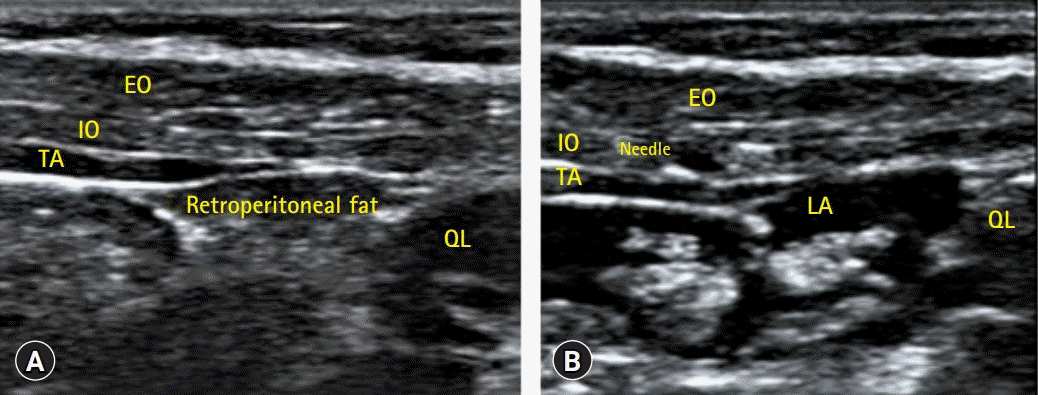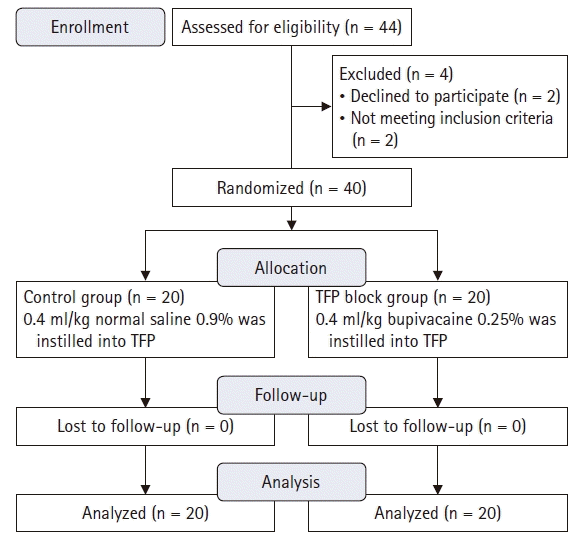1. Jenkins JT, O'Dwyer PJ. Inguinal hernias. BMJ. 2008; 336:269–72.

2. Özdilek A, Beyoğlu ÇA, Demirdağ Ç, Şen Ö, Erbabacan ŞE, Ekici B, et al. Perioperative analgesic effects of preemptive ultrasound-guided subcostal transversus abdominis plane block for percutaneous nephrolithotomy: a prospective, randomized trial. J Endourol. 2020; 34:434–40.

3. Suresh S, Schaldenbrand K, Wallis B, De Oliveira GS Jr. Regional anaesthesia to improve pain outcomes in paediatric surgical patients: a qualitative systematic review of randomized controlled trials. Br J Anaesth. 2014; 113:375–90.

4. Hebbard PD. Transversalis fascia plane block, a novel ultrasound-guided abdominal wall nerve block. Can J Anaesth. 2009; 56:618–20.

5. Black ND, Malhas L, Jin R, Bhatia A, Chan VW, Chin KJ. The analgesic efficacy of the transversalis fascia plane block in iliac crest bone graft harvesting: a randomized controlled trial. Korean J Anesthesiol. 2019; 72:336–43.

6. López-González JM, López-Álvarez S, Jiménez Gómez BM, Areán González I, Illodo Miramontes G, Padín Barreiro L. Ultrasound-guided transversalis fascia plane block versus anterior transversus abdominis plane block in outpatient inguinal hernia repair. Rev Esp Anestesiol Reanim. 2016; 63:498–504.

7. Serifsoy TE, Tulgar S, Selvi O, Senturk O, Ilter E, Peker BH, et al. Evaluation of ultrasound-guided transversalis fascia plane block for postoperative analgesia in cesarean section: a prospective, randomized, controlled clinical trial. J Clin Anesth. 2020; 59:56–60.

8. Aydin ME, Bedir Z, Yayik AM, Celik EC, Ates İ, Ahiskalioglu EO, et al. Subarachnoid block and ultrasound-guided transversalis fascia plane block for caesarean section: a randomised, double-blind, placebo-controlled trial. Eur J Anaesthesiol. 2020; 37:765–72.
9. Ahiskalioglu A, Aydin ME, Doymus O, Yayik AM, Celik EC. Ultrasound guided transversalis fascia plane block for lower abdominal surgery: first pediatric report. J Clin Anesth. 2019; 55:130–1.

10. Voepel-Lewis T, Zanotti J, Dammeyer JA, Merkel S. Reliability and validity of the face, legs, activity, cry, consolability behavioral tool in assessing acute pain in critically ill patients. Am J Crit Care. 2010; 19:55–61.

11. Gill M, Drendel AL, Weisman SJ. Parent satisfaction with acute pediatric pain treatment at home. Clin J Pain. 2013; 29:64–9.

12. Konschake M, Zwierzina M, Moriggl B, Függer R, Mayer F, Brunner W, et al. The inguinal region revisited: the surgical point of view : an anatomical-surgical mapping and sonographic approach regarding postoperative chronic groin pain following open hernia repair. Hernia. 2020; 24:883–94.
13. Willschke H, Kettner S. Pediatric regional anesthesia: abdominal wall blocks. Paediatr Anaesth. 2012; 22:88–92.

14. Aveline C, Le Hetet H, Le Roux A, Vautier P, Cognet F, Vinet E, et al. Comparison between ultrasound-guided transversus abdominis plane and conventional ilioinguinal/iliohypogastric nerve blocks for day-case open inguinal hernia repair. Br J Anaesth. 2011; 106:380–6.

15. Petersen PL, Mathiesen O, Stjernholm P, Kristiansen VB, Torup H, Hansen EG, et al. The effect of transversus abdominis plane block or local anaesthetic infiltration in inguinal hernia repair: a randomised clinical trial. Eur J Anaesthesiol. 2013; 30:415–21.
16. Aksu C, Gürkan Y. Ultrasound guided quadratus lumborum block for postoperative analgesia in pediatric ambulatory inguinal hernia repair. J Clin Anesth. 2018; 46:77–8.

17. Samerchua A, Leurcharusmee P, Panichpichate K, Bunchungmongkol N, Wanvoharn M, Tepmalai K, et al. A Prospective, randomized comparative study between ultrasound-guided posterior quadratus lumborum block and ultrasound-guided ilioinguinal/iliohypogastric nerve block for pediatric inguinal herniotomy. Paediatr Anaesth. 2020; 30:498–505.

18. Aksu C, Gürkan Y. Opioid sparing effect of erector spinae plane block for pediatric bilateral inguinal hernia surgeries. J Clin Anesth. 2018; 50:62–3.

19. Hernandez MA, Palazzi L, Lapalma J, Cravero J. Erector spinae plane block for inguinal hernia repair in preterm infants. Paediatr Anaesth. 2018; 28:298–9.

20. Tulgar S, Yılmazer MS, Kızıltunc B, Thomas DT, Manukyan MN. The combination of ultrasound guided transversalis fascia plane block and transversus abdominis plane block: an alternative method for anesthesia in inguinal herniorrhaphy. J Clin Anesth. 2019; 56:129–30.

21. Sasaoka N, Kawaguchi M, Yoshitani K, Kato H, Suzuki A, Furuya H. Evaluation of genitofemoral nerve block, in addition to ilioinguinal and iliohypogastric nerve block, during inguinal hernia repair in children. Br J Anaesth. 2005; 94:243–6.

22. Carney J, Finnerty O, Rauf J, Bergin D, Laffey JG, Mc Donnell JG. Studies on the spread of local anaesthetic solution in transversus abdominis plane blocks. Anaesthesia. 2011; 66:1023–30.

23. Ghanty I, Schraag S. The quantification and monitoring of intraoperative nociception levels in thoracic surgery: a review. J Thorac Dis. 2019; 11:4059–71.







 PDF
PDF Citation
Citation Print
Print




 XML Download
XML Download